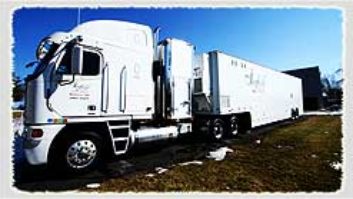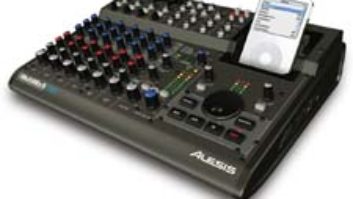September 11, 2001, has become the reference point for a lot of things, including the declining health of the American economy. But rather than an economic turning point, 9-11 was, in fact, a highly visible milestone on a long and bumpy road, which has seen a downhill trend since the NASDAQ peaked in early 2000 and, a year later, has simply fallen at a steeper rate.
While larger indices are still volatile, the stock markets have rallied well since the disaster, and, on the day this article began, the Dow Jones average rocketed up 220 points and finished over the magical 10,000 mark for the first time since September 5. But, for better or for worse, that’s partly because the declining economy has forced many public and private companies (including many in the pro audio sector) to reduce overhead. One result is that over one million jobs were eliminated in the U.S. in 2001. For example, in 1995, when Federal Reserve chairman Alan Greenspan spoke about “irrational exuberance,” the entertainment business included nine major record labels. Now there are only five. Almost every aspect of the entertainment industry has been affected, and film, recorded music and live touring industries saw declines last year. Only computer game sales bucked the trend, perhaps because consumers decided to stay home and “cocoon.”
Recording studios, which have had their own economic issues to deal with for the last decade, did not escape the pressures to streamline, cut back or downsize. However, tough times have brought about a renewed sense of vigor in the survival game. Many studio owners and managers have been forced to place a renewed emphasis on the business side of their operations, a shift that could bode well for the long-term health of the industry.
MARKET BY MARKET
Each of the four major U.S. music recording markets — New York, Los Angeles, Nashville and Miami — has been affected by its own particular geographic issues. New York City was a direct target of the September 11 attacks, which essentially shut down the city for the following week. Businesses were affected proportional to how close they were to Ground Zero. Interestingly, New York’s studios were insulated from a greater immediate impact because the core business of New York high-end studios — rap music — tends to be centered in New York itself, so the shutdown of air traffic caused relatively few previously booked sessions to halt. “Ninety percent of our bookings are locally based,” notes Sound on Sound owner David Amlen.
However, travel restrictions caused a drastic reduction in how far in advance studios get booked, a trend that affects all studio markets. And the transportation shutdown meant that recording media didn’t move, causing session cancellations and missed deadlines. “No FedEx, no tapes, no session,” as Masterdisk president Doug Levine succinctly expresses it. Finally, as America’s financial nerve center, New York had already been feeling the effects of a long-term declining economy, one which has stalled several large post-production facility projects, including the renovation of the vast Brooklyn Navy Yard.
Los Angeles has enjoyed the perception as the most robust American recording market, but studios there reported a slowdown in the aftermath of September 11, particularly among Asian artists, who often use West Coast facilities. “Overall, it’s been good here in L.A., but in the weeks following the attacks we had a few cancellations,” observes Skip Saylor of Skip Saylor Recording. “Two groups from New York that were scheduled to come here stayed in New York instead.”
Nashville’s economic issues are mostly a direct result of being linked to the fortunes of the country music market, which has lost nearly half of its market share since its high-water mark in 1995. Nashville saw a massive expansion of its studio base mid-decade, and the post-9-11 decline has led to several major studios closing and one major bankruptcy. On the other hand, a prolonged slump has driven many facilities to devise creative responses to the economic problems; Nashville’s base of smaller studios has increased to serve the growing number of alternative music artists, and larger studios have pursued a vertical-integration strategy. Nashville is also the center of the contemporary Christian and gospel music genres, both of which have garnered gains in market share in recent years, though they typically operate on a lower budget scale than country music productions.
Miami’s biggest problem is that it is a “destination” music location, dependent, to a large degree, on out-of-town artists and producers (though several artists, including Lenny Kravitz and Missy Elliot, have recently made Miami their home). Latino music’s influence has increased significantly — the genre now has its own NARAS Grammy Awards event — but it remains a niche market, and Miami’s recording scene depends primarily on pop music. While crossover artists like Enrique Iglesias, Gloria Estefan and Ricky Martin are locally based, last summer saw both Michael Jackson and Sean “Puffy” Combs coming to Miami at the same time, setting local studio hearts aflutter. The air traffic shutdown, coming right at the start of the winter season, was a major setback for Miami, and a continuing reluctance to travel, combined with poor economies in parts of Latin America, is an ongoing problem.
RESPONSES
Despite these regional differences, the studio business is very much a part of the larger U.S. economy, and all four markets have expressed similar responses. Some facilities have put off new capital expenditures; others are tapping into current low interest rates to expand or refinance existing debt. For instance, Avatar Studios in New York, NRG in Los Angeles and Sound Stage in Nashville all plan to restructure their debts and renegotiate equipment leases. In addition, the lagging economy has spurred competition among manufacturers. “Prices on a lot of things are great right now,” says Michael Koreiba, manager at Sound Stage. “In an economy like this, you can make good deals.”
Nonetheless, the dramatic drop in advance bookings has clouded the financial crystal ball for many studios. “If people aren’t booking far in advance, at least eight to 10 weeks, it makes it impossible to forecast the coming quarter,” complains Ron Albert, co-owner of AudioVision in Miami, which completed an extensive expansion and renovation project last year. “We’re still in a buying mode, but it makes it tough to spend $2,000 to buy a piece of gear if you’re not sure you’ll need the money toward next month’s console payment. The uncertainty out there is making accurate financial projections difficult.”
On the other hand, some facility managers believe this is a good time to plan expansions. NRG owner Jay Baumgardner says his facility will double to six studios by adding 20,000 square feet sometime this year. Westlake Audio’s studio operations put in a new SSL 9000 J console last July, citing an improved negotiating atmosphere. “Part of our strategy has always been to have the latest and the greatest,” says Steve Burdick, Westlake’s VP of recording services. “Big items cost more, but they allow you to charge more, and at a better price you can pay them off faster.”
Some facilities also see expansion as a good move in down times, but instead are leveraging lower-cost digital technology now instead of purchasing big-ticket items. Kirk Imamura, president of Avatar Recording, says he has plans to add studios to the facility’s fourth floor in the next 18 months, but those new studios will likely be equipped with digital audio workstations, such as Pro Tools, rather than the large tracking studios the company is known for. “It’s cheaper to put in smaller digital platforms,” Imamura says. “And they give us more depth, so that clients can keep more of their project with us, tracking, overdubbing and then editing before mixing. But just as important is the fact that depreciation on a major piece of equipment now is faster. Vintage consoles used to retain value, but today a $500,000 console depreciates very quickly — it makes you think twice.”
In many instances, facilities are adding new services rather than replacing equipment. New York’s Masterdisk is about to add Avid-based video editing capability, which will join the DVD authoring and graphics services it introduced three years ago. “Every new service is an offshoot of our core business of mastering,” explains company president Doug Levine. Interestingly, Levine thought new media would be a logical extension of the services he already rendered to record company clients. Instead, it was catalog film and anime clients who have driven the business. “But the thinking is still sound,” he adds. “I want to expand the range of services I can offer the music industry to cover everything in between actually producing a record and replicating a disc.”
Skip Saylor recently formalized Hit Mixers Management, an engineer management sideline that he started a few years ago, and has turned it into a full-blown business, hiring an additional employee and adding a new office, rather than add studio space. “I manage 15 engineers now, and I only have two studios, so that tells you something,” says Saylor, who adds that he doesn’t cannibalize his studio business by chopping rates for his management company clients’ projects. But discounts are becoming a normal feature of the new business landscape. “What you’re trying to do is get more revenue coming in from more directions, even if it means that each revenue stream has to be adjusted when necessary,” he explains.
With delayed equipment purchases, it might seem reasonable to assume that equipment rental rates would increase, but that apparently doesn’t apply across the board, and rental companies have had to adjust. A good example is Dreamhire, a division of UK-based Zomba Entertainment. Despite the fact that UK record sales increased in 2001, while falling in the U.S., Zomba closed its London branch of Dreamhire, as well as its Battery Studios facility there. In the States, the company is adapting its inventory to accommodate a changing market, such as adding DJ systems at its New York location and working with Brooklyn DJ pool Halcyon as an equipment resource. In addition to its locations in New York and Nashville (where the rental operation expanded when Zomba closed the Battery Studios location there in 1999), Dreamhire has dipped its foot into the Miami market, using South Beach Studios as an agent for selected pieces of gear. If the experiment is successful, the company may open a full branch there in the future. The rental company also has a new role as an online reseller for sound effects company Sonomic’s audio FX libraries. “To put it simply, there are just fewer studios being built these days at a level where it makes the most economic sense to rent to than, say, five years ago,” observes Dreamhire director of marketing Kathryn Dean. “As more record production moves to hard disk recording and plug-ins, there’s less of a rental market to go after, so we have to develop new business strategies.”
BASE-LINE MARKETING
At the most basic level, the recession is compelling facilities to increase their marketing efforts, a time for pro-active promotion. “Staying in touch, going through the Rolodex, letting everyone know you’re there for them, that’s been a big part of it for us,” explains Susan Schilling, studio manager at Transcontinental Studios in Orlando. As Troy Germano, VP of The Hit Factory, puts it, personal relationships remain the cornerstone of the studio business, just as they are in the entertainment business as a whole. “I can’t explain it other than that,” he says. “You don’t just walk out and create relationships instantly; you build and nurture them over years. But they are always the best-selling tool a studio can have, because then you’re not really selling at all. You’re relating to people.” As Jay Baumgardner of NRG puts it, “We market the fact when we have successful records come out of here. We take advantage of the free press that comes with having hits.” Dino Elefante, co-owner of Nashville’s Sound Kitchen, has hired an assistant to help his studio manager spend more time actively churning the city’s client base. “The current economic climate has made us work harder for the business,” says Elefante. “We’re very busy, but we don’t get the entire project ‘soup to nuts’ like we used to. That’s why we also put in new services, like a Sonic editing and mastering suite. But it’s not just a matter of expanding services — you have to let people know you’re doing it.”
OTHER STRATEGIES
Other specific approaches that studios are taking include the tried and true, such as the package deals that studios like The Warehouse in Miami offer. Studio co-owner Ruben Parra saw his mostly Latin American clientele begin to wane as South American economies and travel declined. In response, he developed flat rates for complete projects, rather than rates based on incremental studio time and equipment rentals. “They tell us the budget, we put together a price package for them,” he says, noting that the resulting discounts can amount to as much as 25%. “It keeps the studio busy, which is important,” says Parra. “Though the profit may be smaller, there is still a profit.”
Three Manhattan studios have taken another innovative approach. LoHo Studios, Theater99 and Threshold Music have created a joint marketing and booking venture called United Recording of New York. The three studios agreed to combine their marketing and promotional efforts, and will shuffle clients amongst them to make best use of the unique features of each studio, such as Theater99’s large ambient tracking space.
But perhaps the most unusual response to difficult economic times is that of Fred Vail, owner of Treasure Isle Studios in Nashville. By putting shares in the facility up for auction on Ebay, he has sold 31% of the facility, 22% to an auto parts dealer in Michigan. The capital raised through the sale has funded new gear acquisitions, including a Trident 80 5.1 console, a new RADAR hard disk recording system, miscellaneous outboard gear and microphones, and a down payment on a Yamaha C-7 grand piano.
Complex times call for innovative responses. As Hunter S. Thompson once wrote, “When the going gets weird, the weird turn pro.”
Dan Daley is Mix‘s East Coast editor.
BUSINESS TRENDS TO WATCH
As the prospectus always says, “Past performance is no indication of future earnings.” However, there are certain trends that bear monitoring.
- The long player (LP and CD) concept may have peaked. Singles on physical media have been declining at a double-digit rate, while individual song downloads are growing exponentially. Depending upon how quickly and to what extent downloads replace “bricks-and-mortar” distribution, this could affect the extent to which recording artists choose to work on large projects, like full-length CDs, at the rate of one or two a year. Many artists may transition to an ongoing series of singles or shorter compilations aimed at Internet distribution. (The dance music business has essentially already moved to this model.) A trend away from full-length projects has significant implications for studios that depend upon block bookings.
- Smaller, faster, cheaper. When all types of music recording facilities are taken into account, the overarching move is away from costly, large-format analog platforms and toward inexpensive, small-format digital ones. This trend has been the engine that has driven the growth of the personal/project studio over the last decade, while the number of facilities that can access large-ticket items has declined. However, as long as the need to track large assemblies acoustically remains, so will the need for larger facilities with large-format technologies. A varying number of large studio facilities will remain viable in each major music market. Equipment manufacturers that can leverage high-end brands into lower tiered markets will have an advantage.
- The vinyl effect. In a multiformat world, orphaned formats have more leverage. Vinyl records are more costly and have higher profit margins now that they have been nudged out of the mass market by CDs, and the same rule applies to professional formats. For instance, when someone needs to recover material from the PD digital format, that person may have to pay a higher hourly rate, and a Nashville studio is likely to benefit because the PD format remains widely available. Hundreds of terabytes of data reside on an array of formats now, and many may be hard to find in only a few years. Don’t toss that DAT deck yet. And analog continues to exude allure: i.e., the Museum of Recording’s exhibit at the New York AES. In fact, says Michael Harris of pro audio dealer Harris Audio in Miami, “There’s already a Pro Tools backlash brewing, even in Miami. People are getting a bit bored with the idea of a total solution in a single box. Steven Marley’s new facility here will be based around a [Studer] A800.”
— Dan Daley







